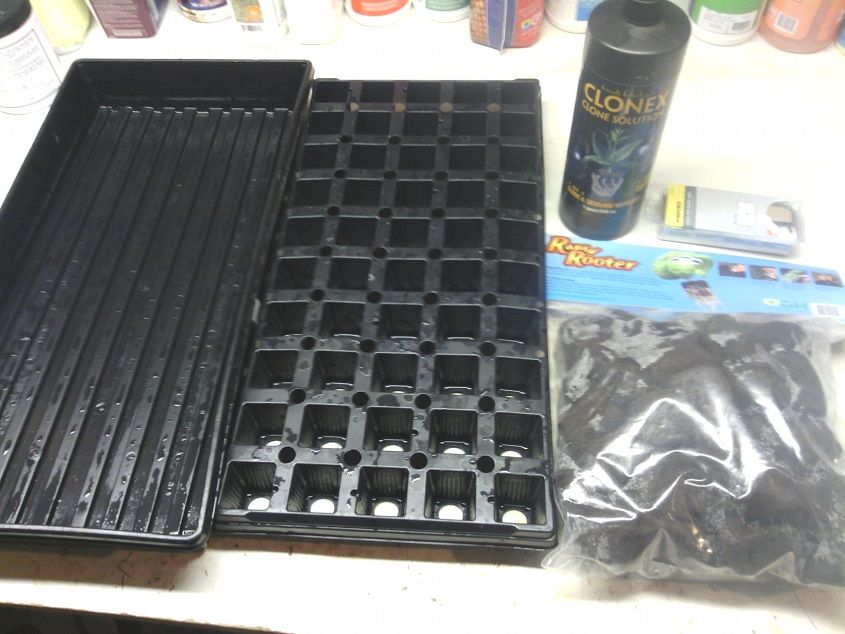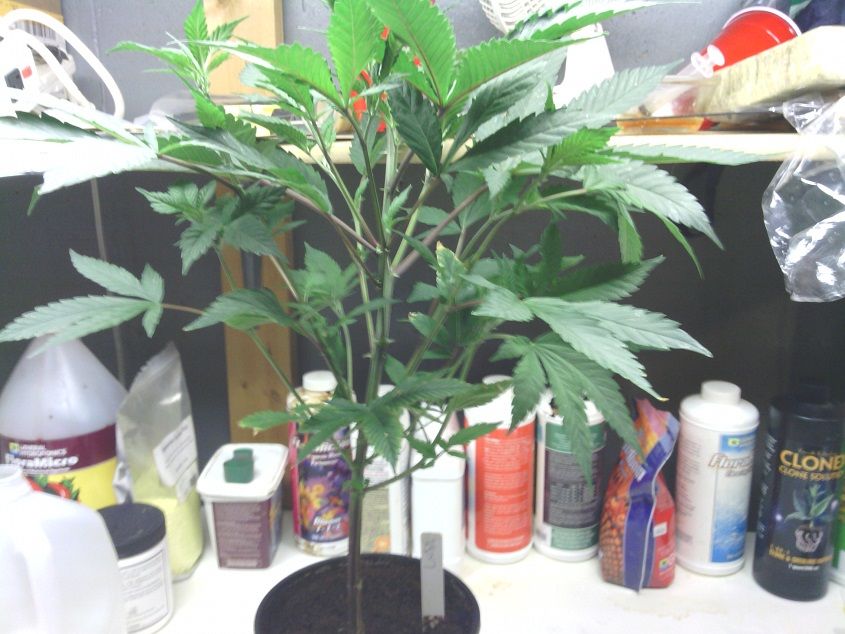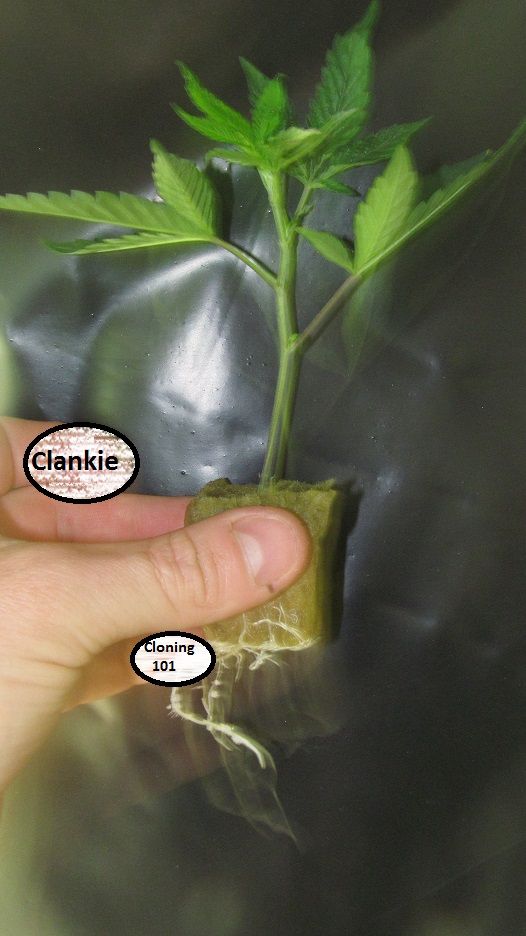Lights
Do not use HIDs for cloning, they are too aggressive and if overlit your clones will need near constant maintenance to avoid wilting and death. Clones need very little light when compared their mother plants. Mine thrive both under t12 and t8 fluorescent lighting as well when positioned immediate outside of a t5 light fixture.
Classic Cube and Dome Cleaning
This is by far the most popular method of cloning, as well as the one I have used the longest, and still use to this day. As far as success rates go, I would say the vast majority (+85%) of the clones I propagate in this manner are successful. I do have a higher success rate with aerocloning, but I am currently in a setup where I am trying to minimize my energy usage as much as possible, and I already have other air pumps running that are absolutely necessary (compost teas and reservoirs). Here are the things you will need for this method:
I use Clonex, I also have excellent results with Olivia's gel (I use clonex because it also works incredibly well in aerocloners, if I feel like using them) and I am currently doing a test run using aloe vera gel fresh from the plant as a rooting agent. I recommend only using distilled water for your clones, and I like to also add a mild dosage of a rooting agent. Both General Hydroponics and House & Garden offer extremely good rooting agents, but for the money I would recommend the root booster from General Organics; I use 5ml/gallon in distilled water and get great results. I love razor blades for cloning, it also helps to have a nice clean pair or scissors/trimmers handy as well. I recommend spraying your plants (if they are in veg) with a mild nitrogen based foliar feed with neem oil the day before you cut clones, even if they are healthy and do not appear to have pests. I also recommend using perlite, growstones, or coco cubes between the cube tray and the bed tray, your roots will greatly appreciate the breathing room. I use rapid rooters and small rockwool cubes interchangeably and have had great results with both. If you use rockwool, prerinsing is always recommended. So, onto the process: here is the plant I will be cloning, a Tranquil Elephantizer: Remix from Bodhi seeds.
You can see that the plant has plenty of healthy branches with three or more node sites, these are what will become your clone plants. I would not recommend cloning from branches with less than three node sites, as they might not have yet developed the strength to support themselves when removed from the mother plant. I recommend starting from the lowest branches, and using your tool of choice remove the branch either at a node site or the node at the stem. Do not leave any branch length on the plant that does not have a node at the end of it, as this will eventually die and mold/rot/etc. Here is a branch freshly removed from the plant:
Now, remove all the branches below the second node from the apical (tip) node, as well as any fan leaves below that point, and I recommend cutting your clone at least 1" below the third node. Increased success can be achieved on plants with large leaves by cutting the leaves in half, thereby halving the amount of water they will transpire. Your manicured clone should look about like this:
I recommend making your final cut on the stem at a 30-45 degree angle, this exposes more stem surface to the medium and rooting agent. Other people have recommended splitting the stem, or shaving off bits of the lower outside stem, I find this unnecessary, and I like the way that a 30-45 degree cut easily stabs into the cube. I cut mine like so:Once you have cut all your clones, if you are not using an anti-wilting agent (discussed later) I recommend misting your clones as soon as you are finished. I mist mine with the same water I use for soaking the cubes, a mixture of distilled water, cloning agent, and GO root booster. Unless the area you are keeping your clones in has an extremely high humidity level, or you are ok with misting them on a fairly regular basis, I recommend using a humidity dome. Clones like a humidity that is well above 70%, particularly for the first few days of their lives. This may require additional misting. I personally recommend giving 'em a mist any time you see the heads on the clones drooping, or just giving them a preventative mist now and then. Don't overdo it, though, as keeping them overly reliant on receiving moisture through the leaves is counterproductive to the overall goal of the process. Unless you are in a seriously dry environment, you should always keep the ventilation on your dome at least half open, and I open the ventilation holes fully on mine 2-3 days after the clones have been cut. It will be necessary to remoisten the cubes every few days using either distilled water or the cloning/water blend, if it becomes necessary to water them more often than once every three days, this is a good sign that roots are forming. However, avoid allowing your bed tray to become waterlogged to the point of coming into contact with the cube tray, the roots need air in that space in order to successfully grow. After around 10-14 days (strain depending) you will start to see roots coming out of the bottom of the cube tray when you lift it up out of the bed. I usually transplant my plants when they have roots formed at least this far:
and the healthy clone looks about like this:
Another good sign that your clones are nearly done in the cloning chamber/dome/whatever is if they start to show signs of nitrogen deficiency, as this means that they are growing vegetatively, and I have rarely seen that on clones that had yet to shoot roots. (or non-rooting shoots)
So that's your classic cloning method, pretty easy and super reliable when the fairly simple conditions are met.
Aerocloning:
Stores will try to sell you cloning machines. DO NOT BUY THEM. There are few things in a hydroponic garden easier to assemble than your own cloning chamber, and you can get excellent results from them. You will need the following things:
- a plastic/rubbermaid style tub with lid. You will want it to be opaque, and I like the ones that are in the 6-10 gallon range.
- neoprene clone inserts: you can find these at most hydroponic stores. There are various homemade options, but I think that the professionally made inserts are best. They are black circles of neoprene usually available between 1"-2" in diameter, and with a radial cut made to hold the clone.
- an air pump. Any time you have fluid being stored for plants, whether in a reservoir, in a DWC bucket, or in a cloning machine, you should always aerate the shit out of it.
- an appropriate size/number of airstones for your container. If you are using a roughly 1"x2" container I would recommend at least two large airstones.
- 1/4" airline/drip tubing to run from the pump to the airstones
- a hole saw or unibit that can make appropriate sized holes in the lid of the rubbermaid container such that the neoprene insert will either sit over the hole or fit into the hole snugly, but not overly tight.
- always use distilled water for cloning.
- in a clone machine, I would recommend using either Clonex or the Clone agent available from Botanicare. I have always used Olivia's for rockwool and rapid rooter clones, but I find that due to the composition it does not perform as well as the other two in automated cloning environments.
- I like to use a small amount of root booster in my cloning solutions, my three favorites are from House & Garden, and then both the version offered by General Hydroponics and the version from General Organics are quite good. 1ml/gallon either H&G or GH, and 5ml/gallon for the one from General Organics
- there are a ton of different cloning options available, and many people even use pure distilled water with good success. My experience would indicate that the purity/PH of the water, and proper humidity, temperature, and oxygen are far more important to the clones than any additional nutrients.
Anti wilting agents
There are a variety of anti-wilting agents on the market, some of which are greatly helpful for cutting clones. Most of these work by forming a semi-permeable seal over the leaf surface on the plant that greatly reduces transpiration, thereby reducing the moisture the plant needs to take in, and keeping freshly cut clones upright and perky even without misting. My absolute favorite of these is Vita Grow's plant based Anti-wilt, and if you are having problems with excessive clone wilting, this stuff will save your life. Cuttings I have treated with this product needed no further misting/spraying and remained healthy completely through the rooting phase, and I highly recommend it.
So there you have it, with these simple propagation techniques, you can ensure a practically lifetime supply of cannabis using only the plants you currently have, and they are the key to any sustainable perpetual grow. Good luck and good cloning!







No comments:
Post a Comment